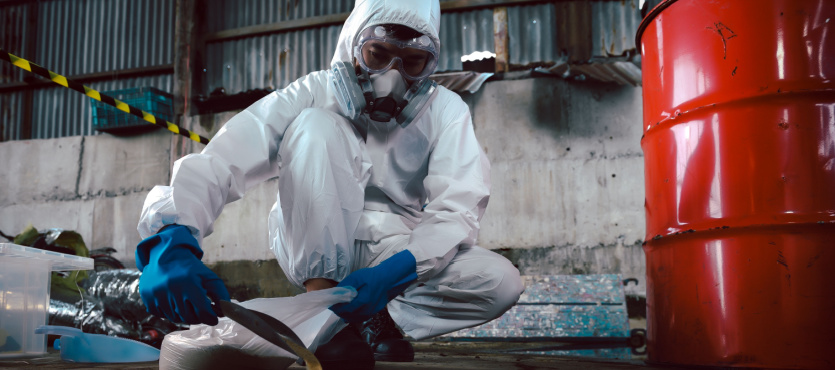The federal government agreed to reimburse Guam for most of the $56 million it spent cleaning up a World War II/Vietnam War-era toxic waste dump.
The settlement represents the U.S. government’s “fair share of remediation costs” for Ordot Dump, a 23-acre landfill opened prior to World War II and operated by the military for decades before being passed to the local government, Guam said in an unopposed motion Friday. The money will only pay cleanup costs incurred prior to Aug. 10, 2022. Total cleanup costs may exceed $160 million.
The Navy opened the landfill for the disposal of “municipal and military waste” and continued to operate it up to 1970, according to court documents.
“While serious concerns remain regarding liability for future costs associated with the Ordot Dump, this settlement represents a significant victory for our island and will enable us to move forward,” Guam Gov. Lou Leon Guerrero remarked.
Toxic Products and the DoD
For many years, the DoD used, and in some cases still uses, asbestos-laced products, weapons with dangerous health side effects, and dangerous bun pit waste disposal areas.
Before 1980, contractors who served aboard naval vessels usually inhaled asbestos fibers. Asbestos does not conduct heat. So, the Navy doubled down on asbestos use after a 1967 fire aboard the USS Forrestal. This fire killed over two dozen people and injured many more.
Asbestos also does not conduct electricity. Electric wires in most military buildings were wrapped in asbestos. Builders typically used chrysotile (white) asbestos. This crumbly substance quickly degrades, releasing poisonous fibers into the air.
20,000 microscopic asbestos fibers can fit in the space between Abraham Lincon’s lip and nose on a U.S. penny. These fibers are small enough to pass through the body’s pores. Therefore, a protective mask is not nearly enough protection.
Asbestos is still technically legal to use. However, it is now so heavily regulated that use in the military is very rare.
Vietnam-era contractors were exposed to Agent Orange as well. For some reason, it never occurred to military brass that chemicals that damaged plants might also damage animals, namely human beings. Some contractors handled Agent Orange drums in the Vietnam theater of operations. Others handled these drums at large storage facilities, like the Agent Orange storage facility in the Marianas Islands.
Countless contractors may have been affected. Breathing Agent Orange fumes was just as deadly as touching the chemical itself.
Burn pits are the toxic exposure injury du jour in American politics, or at least they are at the top of the list. Returning veterans and contractors have told harrowing tales about billowing thick, black smoke and falling ash that was laced with all manner of toxins and particulate matter. The DoD knew the health risks, but apparently decided it was cheaper to pay lawsuit settlements than to develop an effective and safe waste disposal system.
Politicians passed the tug-at-your-heartstrings Honoring our Promise to Address Comprehensive Toxics (PACT) Act. A recent survey showed that the VA denial rate for PACT Act toxic exposure claims, like the aforementioned Ordot Dump, was less than 15%. In contrast, Defense Base Act Administrative Law Judges approve most of these claims, especially if the victim has a good lawyer.
Toxic Waste Exposure Injuries
Cancer might be the most common toxic exposure injury, followed closely by reproductive issues and lung disease.
Survival rates for cancer have shot up since the 1990s, not only because of improved treatment, but also because of improved diagnostic methods. If victims show any signs of cancer, they get tested and get treated.
Toxic exposure cancer is different. Mesothelioma, which is related to asbestos exposure, is a good example. These victims usually show no symptoms, such as fatigue, weight loss, or fatigue, for at least fifty years. So, by the time doctors know there is a problem, their illness is basically untreatable. Mesothelioma’s five-year survival rate is under 10%.
Toxins alter cells, causing them to reproduce too quickly and become malignant. This effect also damages the reproductive system. The same time delay applies. Frequently, when a baby is born with birth defects, doctors do not identify the problem until the child is almost an adult.
These fumes burn the lung, causing scar tissue buildup. Many airways are not much bigger than the tip of a pin. A little scar tissue causes severe breathing problems, especially during periods of physical exertion, such as walking across a parking lot. These illnesses also have very long latency periods. Frequently, when treatment begins, the only option is a radical and risky total lung transplant.
Injury Compensation Available
We do not mean to sound too despondent. Toxic exposure victims usually have viable treatment options, but these options are not cheap.
Under the law, a Defense Base Act insurance company must pay all reasonably necessary medical bills. “Reasonable” is a word like “sooner” or “later.” It means different things in different contexts. Most insurance adjusters take the position that reasonably necessary means the cheapest available.
A Defense Base Act lawyer ensures that these victims get the financial resources they need to fight their toxic exposure diseases, from start to finish. This process includes:
- Initial diagnostic tests,
- Chemotherapy and other drugs,
- Surgical procedures,
- Follow-up medical care,
- Necessary drugs and devices, and
- Physical, respiratory, or other therapy.
Even after this process ends, many victims still require further treatment. A DBA lawyer must ensure that any settlement accounts for these needs. So, if a case settles before medical treatment is at least substantially complete, it might not include such costs, leaving the victim financially responsible for them.
Other DBA financial benefits are available as well, such as partial lost wage replacement. Wage replacement calculation is difficult as well. But that’s the subject of another blog.
For more information about DBA lost wage replacement, contact Barnett, Lerner, Karsen, Frankel & Castro, P.A.

